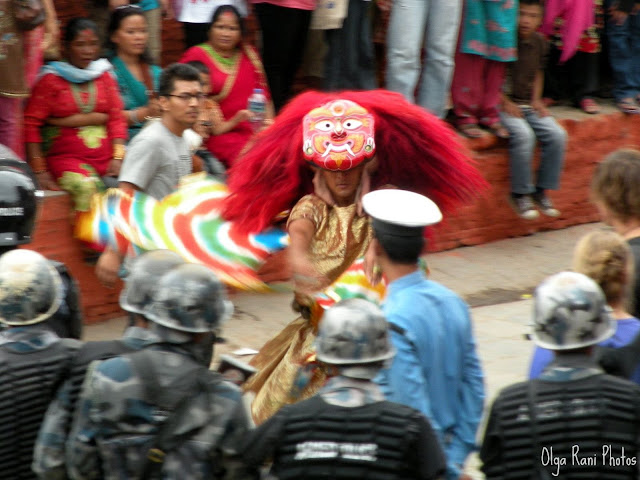The classical Nepali masks always represent deities or demons and never the dead or the ancestors. Besides, masks are more often used in processions and in rituals rather than in theatrical performances.
There are three categories of masks: first, masks representing faces of gods which are worn by performers during ritual dances, a second category, masks which serve as ornamental motifs for decorating a temple, a chariot during a procession or a vase used as a ritual object. A third category includes masks in metal or stone representing faces of deities that are worshiped like statues. They are called statue-masks. The metal used for making them are silver, brass or bronze. These masks are often decorated with jewels and when not worshiped they are kept in a wooden box inside the temple.
Akash Bhairav statue-mask, Indra Chowk, Kathmandu
The masks which are used in ritual dances are made of such materials as papier mache or wood plastered with clay and linen, and are painted in lively colours. So, such masks are never old as they can't survive long in such climate. Besides, according to tradition many masks are supposed to be destroyed after use and be re-made the following year. The oldest known Nepali masks date from the 17th century. The deities represented by masks are numerous: Shiva, Bhairava, Ganesh, Kumari, Varahi, Durga, Laxmi, Sima and Duma, these last two are said to be popular names for lion and tiger. Some people explain that these two masks are a couple, the white-faced Sima being the male; the others think they are two goddesses.
A few words about tribal masks.They have been very little studied. Most of the masks are made of wood and are of human dimensions. In contrast with classical masks, the tribal mask maker it seems had more liberty of expression and could use his imagination more freely.
Tribal mask, Nepal, 19c, musée du quai Branly, photo Thierry Ollivier, Michel Urtado
The masks of the Magar and Gurung tribes are of hardwood covered with a glossy, high patina from exposure to smoke and butter fat. Masks of the lowland Tharu people are often of a softer wood, pigmented with polychrome or white kaolin clay. The Rai people are known to make house-protecting masks from tree fungus while some other masks are created from felt and goat skin. Some of these masks supposedly been used for purposes of healing, oracle augury and life crisis initiations while others - in pantomimes on the occasion of village seasonal festivals or ceremonies dedicated to ancestors.
There is a big selection of masks on sale in Nepal, from cheap paper mache or wooden to very expensive metal ones decorated with semi-precious stones.
Related posts











Awesome article, it was exceptionally helpful! I simply began in this and I'm becoming more acquainted with it better! Cheers, keep doing awesome! Buy KN95 masks online
ReplyDelete